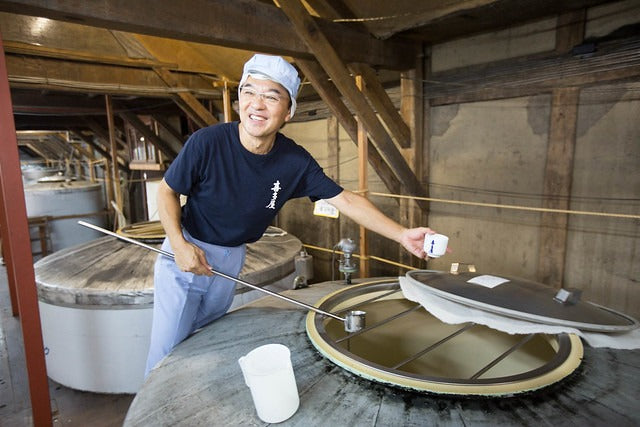It was only a matter of time for Yoko and me to collaborate on a Shochu/Sake Gumi mash-up theme. For September, we are excited to present shuzo (alcohol makers) that make shochu and sake. So you’ll see bottles by Kitaya and Akita Seishu Brewery in both Sake and Shochu Gumi – stay tuned for a Zoom event with Akita Seishu later this month!
 Akita Seishu brewery
Akita Seishu brewery
This theme came about when a member asked during our event, “Is it common for a sake brewery to also make shochu?” That’s a good question – given that there are far more sake breweries than shochu distilleries (1410 vs. 273 respectively, reported in 2020 by the Japan Sake + Shochu Makers Association), it is not that common. But given the popularity of shochu in Japan over the last 50 years, more breweries are making both. Cause why not? It would be an investment in new equipment and technical training, but most shuzo already have access to, and a deep knowledge of the ingredients, especially rice.
What is the difference between sake and shochu? Most simply put, sake is brewed (like beer) and shochu is distilled (like tequila). Both use the mighty koji mold to turn starch into sugar. Sake predates shochu by about 500 years, and it is said that shochu was discovered when someone tried distilling sake in the 1500s. For Shochu Gumi, I wanted to highlight the little known category of kasutori shochu, which is the perfect intersection of sake + shochu. Kasutori shochu is made by distilling sake kasu (lees) – kasu means by-product (in this case the by-product of sake) and tori means ‘to extract’. Most brewers interviewed this month for Shochu and Sake Gumi said they were interested in using their sake kasu to make kasutori shochu, which was their entree to making shochu.

Sake kasu from Akita Seishu Brewery
Many brewers in Japan are now making not only shochu, but also gin, vodka, and even whisky (have you heard?). Aren’t you glad they gave distillation a try?
Kanpai,
Kayoko
Co-Founder and Shochu Director
Umami Mart
+++

Namahage “Devil’s Mask” Kasutori Shochu
Akita Seishu Brewery (Daisen, Akita)
Maker of Sake Gumi bottle Seiden 50 Yamadanishiki
Distilled from sake kasu
ABV 25% / Koji: Undisclosed / Distillation: Vacuum / Age: 1 year
This shochu was created in 1983; the toji (master brewer) at the time wanted to make something using the sake kasu (lees). After sake is pressed, breweries are left with kasu – sediment in cake-like blocks that have about 8% of alcohol left in them. They are able to distill this to make kasutori shochu. Aged in enamel tanks, this shochu is a combination of kasu made of dierent sakes at Akita Seishu. Mr. Sasaki describes the flavors of Namahage as “wild and dry” which pairs well with summery dishes like bualo mozzarella caprese with heirloom tomatoes and avocado, seafood like nizakana, and even richer meals like mabo tofu. I get Asian pear and coconut on the nose and licorice on the palate. Enjoy cold with soda.

Akita Seishu toji Akihiro Sasaki, master brewer of sake and shochu

Rice fields near Akita Seishu Brewery
+++

Nihon No Kokoro Daiginjo Shochu
Kitaya Brewery (Yame, Fukuoka)
Maker of Sake Gumi bottle Kitaya “Pleasureful Family” Junmai Ginjo
Distilled from rice and sake kasu
ABV 25% / Koji: Yellow / Distillation: Vacuum / Age: 5 years
Yoko and I visited this brewery in 2016! It was such a fantastic trip to northern
Kyushu (as seen from Yoko’s photos from Sake Gumi’s Saga Sake feature in July)
and the tour of Kitaya felt modern and prolific. While Akita Seishu only makes one
shochu, Kitaya bottles an array of shochu made of rice, barley, sweet potato, or
local green tea. You can usually find their excellent sake and shochus on our
shelves, even their whisky! Nihon no Kokoro (The Heart of Japan) is a blend of
two shochus: rice (made of Yamadanishiki sake rice milled down to 60%) and
kasutori (made of kasu from a junmai daiginjo with a polishing rate of at least 45%). What’s more, this goes through an extra step in the kasutori shochu production process, where water and ginjo yeast is added to the kasu, then distilled together, which creates complexity and aroma to the final drink. Aged in enamel tanks, this shochu is cold filtered to get rid of unwanted oils while retaining the rich fragrance of banana and jackfruit. Any sake enthusiast will dig this shochu. Enjoy cold or room temperature with smoked chicken tacos or a slice of Basuku cheesecake. Read more about our trip to Kitaya brewery!

Kitaya President Kotaro Kinoshita

Kitaya's trademark smoke stack




Comments (0)
There are no comments for this article. Be the first one to leave a message!